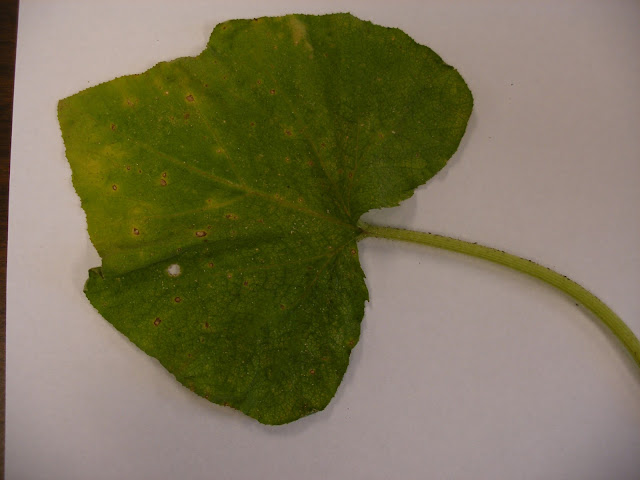The front of the leaf looks unwell, but not spectacularly bad: it is yellowing and is showing some small brown spots inside bright yellow halos. This alone would not be enough to really nail down a diagnosis. (Sorry for the quality of the photos - I was having trouble with the lighting.)
The backside of the leaf is the clincher: it shows the development of the purplish spores of the mildew.
A 2009 article about Downy Mildew, by Debbie Roos, out of NCSU's Growing Small Farms program, includes a useful set of suggestions for managing downy mildew in cucurbits (cucumbers, squash, melons) using organic-growing methods:
"Cultural strategies can help prevent downy mildew. Plant resistant varieties. Plant in locations with good air circulation. Use drip irrigation to minimize leaf wetness.Notice the mention of weather that is "warm and wet and humid"? That is exactly what we have going this month, so this one volunteer squash might not be the only plant in Cobb County to be experiencing the problem. It may be helpful (though disheartening) to know that Powdery Mildew isn't the same as Downy Mildew, so that treatments that work for Powdery Mildew, which many local gardens dealt with last summer, might not work on this different mildew/fungus. (The ATTRA article on Downy Mildew in cucurbits, by George Kuepper, offers similar suggestions to those in the above NCSU article, with caveats that don't appear in the Roos' version, in case anyone is interested in looking at an additional source.)
There are a number of OMRI-listed products purported to help control downy mildew in cucurbits: copper, neem, biofungicides (e.g., Serenade®), peroxides (e.g., OxiDate®), and bicarbonates (e.g., Kaligreen®). According to Dr. Louws, research has shown that copper is the best organic option, but only on the crops that show little to no symptoms. He said if the infection is far along not to bother spraying because it wouldn’t do much good. Spray early in the morning to avoid phytotoxicity problems caused by spraying in the heat of the day. If the disease is present on the farm, a prophylactic application of a copper product can be made to curcurbit crops that show mild or no symptoms. If the weather does not favor the disease (which likes it warm and wet and humid), then the copper is more likely to suppress the disease. In other words, the copper may help but it may not be enough. (See Pesticide Use Guidelines)."
It is a little too late to plant resistant varieties this year, but if anyone has a garden that is particularly plagued by this fungus, selecting a resistant variety for next year might be a good idea. The bad news is that I have been unable to find a good list of resistant cultivars. Apparently, several cucumbers have decent resistance to Downy Mildew, but very few squash do.
However, it is still possible to improve air circulation around existing plants, by pruning or removing nearby other vegetation, even though we can't do much about the rain.
I would whine about how the weather this year is unusually bad for gardening, but it seems to be bad, in one way or another, pretty much every year. There will be a deluge, or a drought, crazy high winds, unusual high temperatures, or unusual cool temperatures, tornadoes, hurricanes or their remnants, hail, falling trees that come across the top of the house and smash parts of the garden.... you get the picture. No year will be The Perfect Gardening Year. Amazingly, we still get plenty of good food out of the garden, and I still love to be working in the yard on my little patches of crops.
Hope that all the other gardens and gardeners out there are growing well!



No comments:
Post a Comment
Note: Only a member of this blog may post a comment.